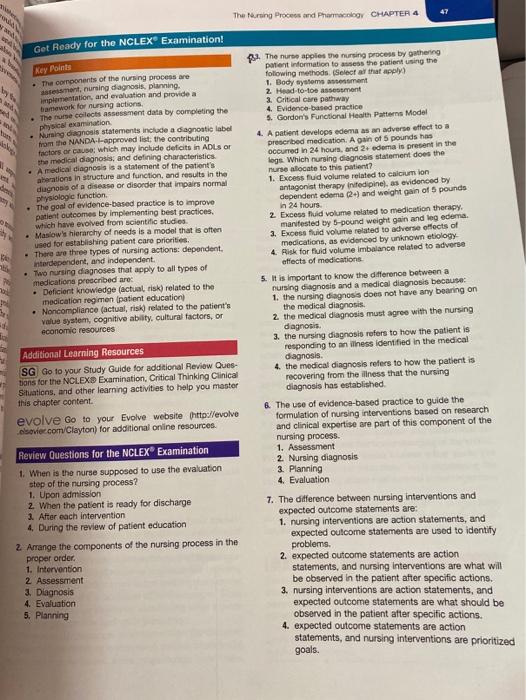
The Nursing Process and Pharmacology CHAPTER 4 Get Ready for the NCLEX® Examination! Key Point The cornponents of the nursing process are sessment, nursing diagnosis planning implementation, and evaluation and provide a bamework for nursing actions • The nurse collects assessment data by completing the physical examination . Nursing diagnosis statements include a diagnostic label from the NANDA-I-approved list the contributing factors or cause, which may include deficits in ADLs or the medical diagnosis and defining characteristics . A medical diagnosis is a statement of the patient's aterations in structure and function, and results in the diagnosis of a disease or disorder that impairs normal physiologie function The goal of evidence-based practice is to improve patient outcomes by implementing best practices. which have evolved from scientific studies • Maslow's hierarchy of needs is a model that is often used for establishing patient care priorities. There are three types of nursing actions: dependent interdependent, and independent, • Two nursing diagnoses that apply to all types of medications prescribed are: • Deficient knowledge (actual risk) related to the medication regimen patient education • Noncompliance (actual, risk) related to the patient's value system, cognitive ability, cultural factors, or economic resources The nurse applies the nursing process by gathering patient Information to assess the patient using the following methods (Select all that apply) 1. Body systems asment 2. Head-to-toe assessment 3. Critical care pathway 4. Evidence-based practice 5. Gordon's Functional Health Patterns Model 4. A patient develops edema as an adverse effect to a prescribed medication. Again of 5 pounds has Occurred in 24 hours and 2 edema is present in the Sege. Which nursing diagnosis statement does the nurse allocate to this patient? 1. Excess flud volume related to calcium ion antagonist therapy inifedipine), as evidenced by dependent edema (2) and weight gain of 5 pounds in 24 hours 2. Excess fluid volume related to medication therapy. manifested by 5-pound weight gain and log edema. 3. Excess fluid volume related to adverse effects of medications, as evidenced by unknown etiology 4. Risk for fluid volume imbalance related to adverse effects of medications 5. It is important to know the difference between a nursing diagnosis and a medical diagnosis because 1. the nursing diagnosis does not have any bearing on the medical diagnosis. 2. the medical diagnosis must agree with the nursing diagnosis 3. the nursing diagnosis refers to how the patient is responding to an illness identified in the medical diagnosis 4. the medical diagnosis refers to how the patient is recovering from the illness that the nursing diagnosis has established 6. The use of evidence-based practice to guide the formulation of nursing interventions based on research and clinical expertise are part of this component of the nursing process 1. Assessment 2. Nursing diagnosis 3. Planning 4. Evaluation 2 Additional Learning Resources SG Go to your Study Guide for additional Review Ques- Bons for the NCLEX® Examination, Critical Thinking Clinical Situations, and other learning activities to help you master this chapter content evolve Go to your Evolve website http://evolve olevier.com/Clayton) for additional online resources. Review Questions for the NCLEX® Examination 1. When is the nurse supposed to use the evaluation stop of the nursing process? 1. Upon admission 2 When the patient is ready for discharge 2. After each intervention 4. During the review of patient education 2. Arrange the components of the nursing process in the proper order. 1. Intervention 2 Assessment 3. Diagnosis 4. Evaluation 5. Planning 7. The difference between nursing interventions and expected outcome statements are: 1. nursing interventions are action statements, and expected outcome statements are used to identify problems. 2. expected outcome statements are action statements, and nursing interventions are what will be observed in the patient after specific actions. 3. nursing interventions are action statements, and expected outcome statements are what should be observed in the patient after specific actions. 4. expected outcome statements are action statements, and nursing interventions are prioritized goals.
没有找到相关结果